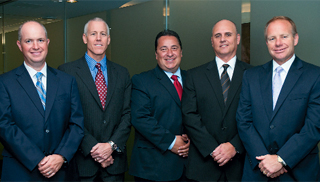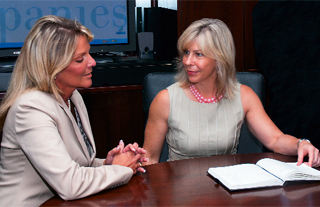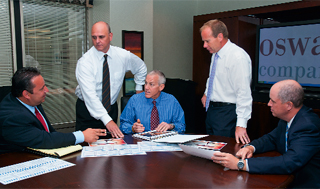|
Capitalizing on Benefits
Variety is the "spice" of the benefits world
Ohio agency challenges the status quo
By Len Strazewski
One size rarely fits all in the world of employee benefits. Employers come in all sizes and styles, and their employee benefit strategies vary by industry, region and human resources needs. Employers also vary in their ability to implement progressive employee benefit management strategies. Are they willing to accept some financial risk? Can their executives and employees commit to wellness and health management programs? Are they willing to team up with other employers?
Oswald Companies, an employee-owned independent agency based in Cleveland, Ohio, with nine offices in six states, provides a wide range of employee benefit management options to its clients, from homogeneous associations for small businesses struggling to get control of rising costs, to captive insurance companies for large employers that want to make best use of their financial assets.
Founded in 1893, Oswald has always had a powerful presence in Ohio and Kentucky where small manufacturers have been the backbone of the local economy. In 1991 the agency began expanding its employee benefits practice, bringing a new level of sophistication to employers of all sizes in its region. As a result, employee benefits sales and service has become a booming component of agency business. According to President Bob Klonk, about 45% of Oswald's revenue is derived from employee benefits.
"Our goal is to achieve 10% to 12% organic growth annually for the agency, and we expect benefits to also grow at that rate," he says. The agency has about 245 employees and approximately 84 in benefits-related services.
Challenging the status quo
Eric Krieg, senior vice president, says employers of all sizes face some common challenges. Controlling health care costs is an issue for all Oswald clients, and most employers are striving to encourage employee engagement in health care cost issues, communicating the "value equation" to employees who consume health care.
"Our goal is to really challenge the status quo," Krieg says. "Employers have been doing the same things over and over again—re-quoting their health plans, shifting more costs to employees, changing plan design—without really affecting the factors that influence costs. Today, quoting renewals is a small part of what we do.
"What we are doing is leading our clients to be more proactive and help them develop an intelligent, strategic plan that over a three- to five-year period can have a serious impact on their costs."
Small employers have the least direct influence on their group health rates. Health plans usually community-rate employers with fewer than 50 employees, allowing little opportunity for proactive influence.
However, Oswald has succeeded in associating groups of small employers to help share health risks and improve their health underwriting profile. For example, the agency serves as a wholesale broker for ERC Health, a group health plan for the Employers Resource Council, an association of 1,400 small employers.
The agency works with about a dozen small agents and brokers who market health plans underwritten by Anthem BlueCross/BlueShield and United Healthcare. Tony Barisono, benefits practice leader and director of the ERC program, says the association allows the agency to introduce wellness strategies and health risk assessments to the employer groups and use the health management program to shape improved underwriting and rates from the insurers.
The program also allows Oswald to establish a tracking system that rewards employers for better loss ratios and reduced health risks. The collected data is an eye-opener for participants, Barisono says. "It's a real education for employers as they can see their loss ratio and loss experience—and how they have been able to influence them."
Frank Spinelli is practice leader for the middle market in Oswald's Cleveland office, which serves employers with 50 to 750 employees. For these companies, cost control continues to be a driving issue, but reducing risk is also a priority. "Of course they want to keep costs in line, but they are also committing to identifying their risks and putting programs in place to change their risk profile," Spinelli says.
Oswald provides a team of specialists for middle market employers, led by a senior consultant to help them develop a strategic plan, a client manager for day-to-day execution, and individual experts for specific approaches. "Our team has become very deep in health management," Spinelli says, "and we have acquired expertise in a broad range of health services: nurses, dietitians, exercise physiologists."
Human resources services have also become increasingly important for the agency, adds Paul Catania, vice president, middle market practice leader and Akron office branch manager. "Middle market employers don't have the administrative depth that the largest employers do. As a result, they may not have the ability to execute the kinds of programs we know they need to have. So we become extensions of their human resources and finance departments and take on some of the administrative tasks. If you can't do it, we can do it for you."
Catania calls these tasks "E3" for "education, engagement and enrollment" and emphasizes that they are critical for successful employee benefits management.
Wellness and health management
Wellness and health management has become a critical component of employee benefits for many Oswald clients—and both the employers and the agency are receiving national recognition for their achievements.
Last May, the Institute for Health and Productivity Management (IHPM) in Scottsdale, Arizona, honored Oswald client SafeAuto Insurance Companies in Columbus, Ohio, with its Value-based Health Award. The award is given to employers who demonstrate excellence in health care management, building a culture that establishes the value of employee health and its impact on business performance.
The award program was launched in 2007. Past recipients include Johnson & Johnson, Dow Chemical, John Deere, Pitney Bowes, Procter & Gamble and Intel.
With help from Oswald, SafeAuto executed a strategic multi-year program that focused on the award assessment categories: Culture of Health, Process and Implementation, Program Design, Measurement, Provider/Stakeholder Relations, and Communications/Branding. The award also recognizes success in reducing health risks and future costs, improving clinical outcomes, and increasing employee engagement to improve lifestyle behaviors.
The SafeAuto program, "Hi Gear: on the road to better health," resulted in more than 90% employee participation in key wellness program activities, as well as improvements in employees' and spouses' cardio-metabolic risk factors, preventive care compliance, and medication adherence, and a 20% reduction in health care costs—without shifting costs to employees.
Among other program elements, SafeAuto provides health savings accounts, on-site health coaches, healthful food options, discounts on health insurance premiums for wellness participation and attaining health measures, and free preventive prescription drugs.
"What you're seeing with SafeAuto is real health reform in action at the employer level, making a difference for real people," says Neil Quinn, Oswald's vice president and director of health management services. "By setting aggressive goals for health improvement and cost control, aligning incentives, providing wellness resources for employees, and celebrating successes, SafeAuto has created a positive health ecology that is sustainable."
The program established a system that influenced a number of health quality variables that will continue to pay the company and its employees dividends in the future, Quinn says.
Oswald has been providing wellness and health management services since 2000, and executives see it as a natural next step in employee benefit cost control. For many years, Quinn comments, employers and their agencies have been managing the insurance product aspects of benefit plans and health networks, squeezing value from the plan design. But while this process helped employers manage increasing costs to some extent, it did not address the underlying health risks that drive costs.
"What else can we bring to the employer population?" Quinn says. "The answer was health management, harnessing employer leadership and employee engagement to address the client's risk profile—and create an ecology that can have a braking effect on health claims and resulting costs."
Quinn says about one-third of Oswald's clients are deeply involved in health management programs, one-third are "on the bubble" and engaged in developing serious programs, and another third are waiting for an opportunity to engage in comprehensive programs.
"You cannot go small in wellness," he says.
Large employers and large groups of small to mid-sized employers have greater risk management resources than small, individual clients, and a greater ability to assume greater portions of financial risk. For employers with a little more appetite for risk, Oswald is developing alternative risk management structures and captive insurers to help employers and groups self-fund health risks,
Todd Miller, senior vice president and branch manager in Oswald's Columbus office, says the agency has several captive projects under development for employer groups and professional employment organizations (PEOs). He says the alternative risk approach to employee benefits "is very powerful," and more and more domestic captive insurer domiciles are interested in benefits projects. They include Vermont, Montana, Nevada, Delaware, and the District of Columbia.
The captives enable participants to reinsure some of their health plan risks and give them direct access to the international stop-loss insurance market. The alternative risk structure also provides a platform for more direct control of health network discounts and pharmacy management services. Captive program participants, Miller says, must commit to "a significant reduction in risk" and must agree to engage in health management and other activities to reduce utilization and claims costs.
The author
Len Strazewski is a Chicago-based writer, editor and educator specializing in marketing, management and technology topics. In addition to contributing to Rough Notes, he has written on insurance for Business Insurance, Risk & Insurance, the Chicago Tribune and Human Resource Executive, among other publications.
|
|
| |
 |
| |
From left: Paul N. Catania, CEBS, PHR, Vice President and Branch Manager; Neil Quinn, Director and Vice President, Health Management Services; Frank Spinelli, Practice Leader for the Middle Market, Group Benefits; Tony Barisono, Vice President and Practice Leader, ERC Health; and Eric L. Krieg, Senior Vice President, Group Benefits. |
| |
 |
| |
Brenda S. Gainer, RHU, PHR, GBA, Senior Consultant, Labor Relations Practice (left), meets with Nancy A. Kingsland, Business & Proprietary Program Development, Group Benefits. |
| |
 |
| |
Oswald provides a team of specialists for middle market employers, led by a senior consultant to help them develop a strategic plan, a client manager for day-to-day execution, and individual experts for specific approaches. |
|